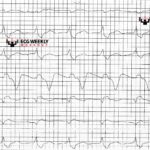Rhythm Interpretation
Latest
STAT ECG Diagnoses: getting rhythm strips right and knowing when acute intervention is needed
A 66-year-old man is transferred to the ED from an urgent care where he presented for shortness of breath and was diagnosed with heart failure. He was recently discharged s/p…
STAT ECG Diagnoses: the definition of electrical storm and what you need to know about it
A 58-year-old man with PMHx of cardiomyopathy (EF ~30%) presents to the ED with intermittent episodes of palpitations and near syncope. The following ECG was obtained during an episode:
Bradyarrhythmias: what to consider when an unstable bradycardia is not reponding to standard ACLS treatments
A 60-year-old woman presents to the ED with dyspnea on exertion and malaise. She is hypotensive and bradycardic. The following ECG is obtained:
Literature Review: pearls and pitfalls in the ECG diagnosis for ventricular tachycardia
A 45-year-old with no known past medical history presents to the ED with palpitations. She is hemodynamically stable. The following ECG is obtained:
STAT ECG Diagnoses: bizzare rhythm interpretation tips
An elderly patient is hospitalized with severe sepsis and multi-organ system failure. The following rhythm is noted on cardiac monitoring:
STAT ECG Diagnoses: diagnosis of acute myocardial infarction (MI) in patients with paced rhythms
An 86-year-old female with PMHx of CAD and pacemaker placement presents to the ED with acute chest pain. Pain has been radiating to the right upper extremity for 1 hour…
STAT ECG Diagnoses: ventricular rhythms in patients being evaluated for acute coronary syndromes (ACS)
A 45-year-old male presents to the ED with chest pain and diaphoresis. He is being treated for a suspected MI and is noted to have a change in rhythm. The following…
AV Block Bootcamp (Episode 3/3): the answer lies in the PR interval!
HPI: A 72-year-old female presents to the ED with chest pain and lightheadedness. The following ECG is obtained:
AV Block Bootcamp (Episode 2/3): what is the atrium doing, what is the ventricle doing, and what is their relationship?
A 72-year-old female presents to the ED with dyspnea. The following ECG is obtained:
STAT ECG Diagnoses: what to consider when dealing with grouped or clumped beats causing irregular rhythms
A 95-year-old female presents to the ED with vomiting and abdominal discomfort. The following ECG is obtained:
ECG Basics & Fundamentals: cardiac rhythm strips and how to identify the three main types of ventricular tachycardia
A 58-year-old woman with PMHx of HTN and polysubstance abuse presents to the ED after a syncopal episode. She has been having nausea, vomiting, and diarrhea. She is noted to…
ECG Basics & Fundamentals: ventricular rhythms to be aware of in patients with cardiac ischemia
A 50-year-old man presents to the ED with ischemic chest pain concerning for acute MI. During his work up and observation, he clinically improves but is noted to have a…
ECG Basics & Fundamentals: how common is artifact?
A 72-year-old man presents to the ED with near-syncope. During his evaluation he has a 20-second run of the following rhythm captured on 12-lead ECG monitoring:
STAT ECG Diagnoses: arrhythmias after thrombolysis for myocardial infarction (MI)
An 86-year-old man presents to the ED with substernal chest pressure, diaphoresis, and vomiting. The following ECG is obtained:
Differential Diagnoses: narrow complex regular tachycardias
A 64-year-old man presents with palpitations. The following ECG is obtained:
ECG Basics & Fundamentals: interval abnormalities can cause clinical uncertainty
A 40-year-old man presents with concerning chest pain. The following ECG is obtained:
Rhythm Interpretation: never trust the computer interpretation and scrutinize every lead
An elderly male presents with weakness and lightheadedness to his primary care physician. He is referred to the ED after the following ECG is obtained:
Rhythm Interpretation: grouped or clumped beats
A 67-year-old male with PMHx of ESRD presents to the ED with fevers and bacteremia. The following ECG is obtained for mild tachycardia:
Rhythm Interpretation: how to avoid misdiagnosis of atrial fibrillation
An elderly male presents to the ED after a syncopal episode. He is found to be weak and lightheaded on arrival, with hypotension and mild tachycardia. There is no evidence…
Rhythm Interpretation: distracted by ectopy!
HPI: A 51-year-old male presents to the ED with dyspnea, nausea, and palpitations. The following ECG is obtained: Case ECG Before watching this week’s video, ask yourself these questions:…
Free Content
Jump on our email list for free tips and insights delivered to your inbox monthly. No spam - just quick pearls and ECG education.
Categories
- No categories






















